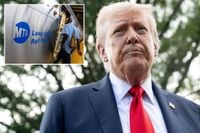On a brisk Monday morning in mid-September 2025, a crowd of NASA employees and supporters gathered outside the agency’s headquarters in Washington, D.C., their voices rising in protest against sweeping funding and staffing cuts. The demonstration, organized by the grassroots group NASA Needs Help, was a direct response to proposed budget reductions that could slash NASA’s funding by nearly 25% and to a recent executive order from President Donald Trump stripping NASA workers of their collective bargaining rights. Protesters, standing shoulder to shoulder, chanted, “When NASA is under attack, what do we do? Rise up, fight back!”
“NASA is a tangible product of the greatest expression of the American dream. Dismantling this American institution is a travesty that no one voted for,” declared Colette Delawalla, executive director of Stand Up for Science, as reported by Federal News Network. Delawalla’s words echoed the fears of many at the rally, who see the agency not just as a workplace but as a symbol of national aspiration, scientific leadership, and public good.
The protest comes at a time of heightened anxiety for NASA’s workforce. The Trump administration has aggressively pursued funding cuts and personnel layoffs across federal scientific agencies, and NASA has become one of the biggest casualties. According to Federal News Network, the agency has already lost nearly 4,000 employees—about 20% of its workforce—through a deferred resignation program. Now, with the executive order cancelling collective bargaining rights, thousands more scientists, engineers, and technicians face the loss of union protections that have safeguarded their interests for decades.
The administration’s justification for the executive order is national security. By cancelling collective bargaining rights at multiple federal agencies, including NASA, officials argue that the roles performed by these workers are tied to national interests. But Monica Gorman, area vice president of the Goddard Engineers, Scientists and Technicians Association, flatly rejected this rationale. “NASA is not an intelligence agency. NASA is a scientific agency. And NASA workers have been collectively bargaining for decades with no harm to national security. This is just a pretext for expanding Trump’s attack on the labor movement as a whole,” Gorman asserted at the rally.
The executive order’s impact is far-reaching. NASA’s implementation includes terminating collective bargaining agreements, halting the collection of union dues, and evicting unions from their office spaces. Gorman, who works as an operations research analyst at NASA, emphasized the importance of union protections in fostering a culture where employees can voice concerns without fear of retaliation. “A huge part of the reason that I have that independence and that my colleagues do is that as a union-represented worker, I know that I am protected from unfair retaliation,” she explained. Gorman referenced NASA’s history, recalling tragedies like Apollo One, Challenger, and Columbia, noting that “these catastrophes don’t happen out of nowhere. People see them coming. People have concerns, and if people don’t feel safe at work, if they don’t have the trust that they can speak up and bring those concerns forward without retaliation, then those concerns get buried.”
Matthew Biggs, president of the International Federation of Professional & Technical Engineers, announced that NASA would soon be added to an ongoing lawsuit challenging the executive order’s termination of collective bargaining rights. “They’re not going to eliminate us. We are going to survive. We’re going to continue to represent our members. We’re going nowhere,” Biggs declared. He argued that the administration’s real motivation was to “silence the workforce” and make it easier to implement reductions in force without union resistance.
The protest wasn’t just about NASA. Speakers called on Congress to pass a “fighting” continuing resolution that would include protections for scientific federal agencies, as the deadline to avoid a government shutdown loomed ever closer. Lawmakers have until midnight on September 30 to pass a funding bill. While the House has proposed maintaining NASA’s budget at last year’s level, the Senate’s version would provide a slight increase. Meanwhile, the White House is pushing a proposed NASA budget of $18.8 billion for fiscal year 2026—a staggering 24% decrease from the approximately $24.8 billion allocated in 2025. The proposed cuts would target NASA’s entire satellite program and core science research areas, including astrophysics, planetary science, and heliophysics. Casey Dreier, chief of space policy at The Planetary Society, described the proposal as “an extinction-level event.”
The turmoil at NASA is part of a larger national conversation about labor rights, federal workforce policy, and the future of public sector unions. Just a day after the NASA protest, President Trump again wielded executive authority—this time to intervene in a labor dispute involving Long Island Rail Road (LIRR) workers. According to AFP and the New York Post, Trump’s order established a federal emergency board to mediate contract negotiations between LIRR unions and the Metropolitan Transportation Authority (MTA), triggering a 120-day “cooling off period” during which neither side can change wages, hours, or working conditions, and workers cannot legally strike. The board, composed of three members appointed by Trump, has 30 days to review contract proposals and issue recommendations.
The LIRR dispute had been simmering for weeks, with five unions representing about half of all LIRR employees authorizing what would have been the first strike since 1994. Labor leaders, however, delayed the walkout and requested federal intervention. The sticking point was pay: the MTA offered a 9.5% raise over three years, while unions sought a total 16% increase, later signaling willingness to accept the lower figure if a fourth year was added to the deal. New York Governor Kathy Hochul, for her part, urged both sides to “work it out at the table,” expressing her opposition to strikes and emphasizing negotiation over confrontation.
While federal workers and transit employees navigate executive orders and labor disputes, some local government employees are celebrating a milestone. In Fairfax County, Virginia, thousands of county workers represented by SEIU Virginia 512 are preparing to vote on ratifying their first union contract. The tentative three-year collective bargaining agreement covers about 11,600 general county employees, including park, library, and public works staff, as reported by The Dogwood. The deal promises pay increases, higher salary range maximums, a protected telework policy, compensation for multilingual skills, and the creation of labor management committees to foster better communication between employees and management.
“These are things that we have hoped for through the years,” said Tammie Wondong, a longtime county social worker. LaNoral Thomas, president of SEIU Virginia 512, called the tentative agreement “yet another example of what happens when workers are united.” Fairfax County’s breakthrough was made possible by a 2023 ordinance granting local government employees the right to collectively bargain, following a 2020 state law signed by former Governor Ralph Northam that lifted a longstanding ban on collective bargaining for some public employees. Still, labor leaders and some Democrats are pushing for broader legislation to allow all public sector employees to collectively bargain without needing local approval—a measure vetoed earlier in 2025 by Republican Governor Glenn Youngkin.
As the October ratification vote approaches, Fairfax County union leaders are meeting with members to explain the contract’s details and protections. The contrast between the optimism in Fairfax and the anxiety at NASA could not be more stark. Across the nation, the battle lines over labor rights, public sector protections, and the role of government in safeguarding scientific and technical expertise are being redrawn. The coming months will reveal whether workers’ voices—at NASA, on the rails, and in local government—can shape the future of America’s public institutions, or whether executive orders and budget cuts will decide their fate.




